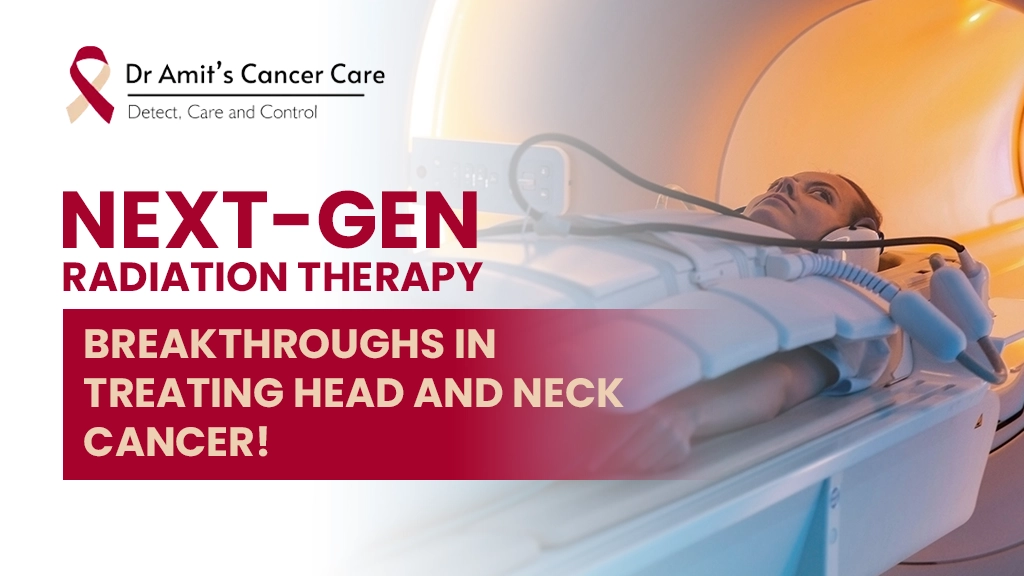
Next-Gen Radiation Therapy : Breakthroughs in treating head and neck cancer
When you hear the word radiation, most people think of something rigid, cold, and overwhelming. What they rarely imagine is precision. Personalization. And progress.
But that’s exactly what modern radiation therapy is becoming especially for patients with head and neck cancers. With the latest innovations, we’re entering a time where treatment doesn’t just aim to kill cancer. It’s also focused on protecting the voice, the smile, and the way someone swallows or breathes.
This is not science fiction. It’s happening right now, and here’s how.
Proton Therapy: Precision Where It Matters Most
In head and neck cancer, accuracy isn’t a luxury it’s survival with quality. Proton therapy brings a level of focus we didn’t have before.
Unlike traditional radiation, which passes through the body, protons stop when they hit the tumor. That single difference means less radiation reaches the healthy tissues around the cancer like salivary glands, throat muscles, or the voice box.
Why patients notice the difference?
-
Less dryness in the mouth
- Lower chance of long-term swallowing problems
- Fewer effects on hearing or memory
Proton therapy isn’t available everywhere yet, but in major cancer centers and some hospitals in India, referrals are now possible through advanced programs. If you're in Mumbai, an experienced oncology specialist in Mumbai can guide you through your options.
Real-Time Tracking: Radiation That Moves With You
Most people don’t realize that during treatment, the tumor might shift slightly. You might swallow. Breathe. Even a tiny movement can change the target.
That’s where real-time tracking comes in. This tech allows radiation beams to follow the tumor—even as your body moves.
Why this matters:
-
It protects healthy organs around the tumor
- It reduces the chance of missing the target
- It helps use lower doses, with better results
This is especially helpful in treating cancers near the throat or jaw, where every movement counts. If you’re exploring treatment options, consult a head and neck cancer treatment specialist who uses systems with real-time adaptive control.
Adaptive Radiotherapy: Treatment That Learns and Responds
This is one of the most exciting advances. With adaptive radiotherapy, your treatment isn’t fixed. It adjusts just like your body does.
If your tumor shrinks, the radiation field is updated. If there’s swelling or weight loss, the system recalculates. Each session becomes more tailored, more accurate, more effective.
What this means for you?
- A plan that evolves with your healing
- Fewer complications as treatment progresses
- Higher success rates without needing more aggressive therapy
With adaptive technology, you’re not locked into a static plan. You’re being treated based on how your body is responding that day. This level of precision and flexibility is already being used in advanced hospitals across India and is becoming part of standard care in major cities like Mumbai.
What Patients in Mumbai Should Know?
Mumbai is not just a healthcare hub it’s home to some of the most advanced cancer care in the country. If you're newly diagnosed, the first step is to speak with a trusted oncology specialist in Mumbai who understands how these technologies work together.
Look for centers that offer:
- Adaptive Radiotherapy
- IGRT (Image-Guided Radiation Therapy)
- Access to proton therapy referrals or partnerships
- A dedicated head and neck cancer team
When you consult a head and neck cancer treatment specialist, ask if your plan will adapt with time. Ask how side effects will be minimized. And ask what recovery might realistically look like not just for your body, but for your voice, your appetite, your daily life.
Real Testimonials from a Real Patient
Ritika, 39, teacher from Navi Mumbai
"I was terrified of radiation. I thought I’d lose my voice, my strength. But what I didn’t know was how advanced it’s become. My treatment changed halfway because my tumor was responding. The machines adjusted everything. I never knew radiation could be this precise."
Thought: This Is the New Standard
This is what next-generation radiation looks like it’s not just smarter. It’s kinder. It sees the patient, not just the tumor.
If you or someone close to you is facing head or neck cancer, know this: you have options. And with the right team and the right timing, radiation therapy doesn’t have to be the scariest part of the journey.
It might just be the most hopeful.
